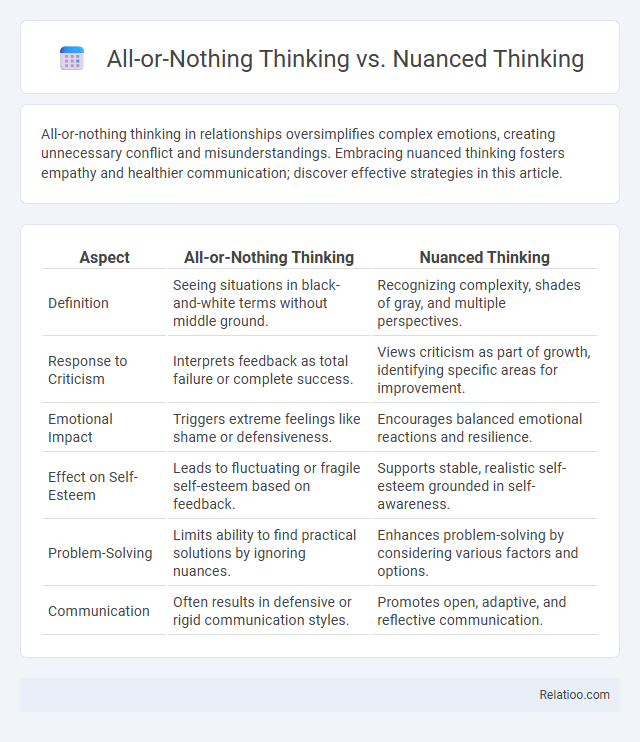All-or-nothing thinking in relationships oversimplifies complex emotions, creating unnecessary conflict and misunderstandings. Embracing nuanced thinking fosters empathy and healthier communication; discover effective strategies in this article.
Table of Comparison
| Aspect | All-or-Nothing Thinking | Nuanced Thinking |
|---|---|---|
| Definition | Seeing situations in black-and-white terms without middle ground. | Recognizing complexity, shades of gray, and multiple perspectives. |
| Response to Criticism | Interprets feedback as total failure or complete success. | Views criticism as part of growth, identifying specific areas for improvement. |
| Emotional Impact | Triggers extreme feelings like shame or defensiveness. | Encourages balanced emotional reactions and resilience. |
| Effect on Self-Esteem | Leads to fluctuating or fragile self-esteem based on feedback. | Supports stable, realistic self-esteem grounded in self-awareness. |
| Problem-Solving | Limits ability to find practical solutions by ignoring nuances. | Enhances problem-solving by considering various factors and options. |
| Communication | Often results in defensive or rigid communication styles. | Promotes open, adaptive, and reflective communication. |
Understanding All-or-Nothing Thinking
All-or-nothing thinking is a cognitive distortion characterized by viewing situations in extreme, black-and-white terms without recognizing middle ground or complexity. This type of thinking often leads to unrealistic expectations and increased emotional distress, as it ignores the nuanced spectrum between success and failure. Understanding all-or-nothing thinking involves identifying these rigid thought patterns and gradually adopting more balanced, flexible perspectives that reflect the complexity of real-life experiences.
What Is Nuanced Thinking?
Nuanced thinking involves recognizing the complexity and multiple perspectives within a situation, avoiding binary judgments typical of all-or-nothing thinking, which sees issues in black-and-white terms. Unlike cognitive distortions that simplify reality through irrational thought patterns such as catastrophizing or overgeneralization, nuanced thinking fosters balanced evaluation and deeper understanding. This cognitive approach enhances decision-making and emotional regulation by acknowledging varying degrees of truth and uncertainty in experiences.
Key Differences Between All-or-Nothing and Nuanced Thinking
All-or-nothing thinking categorizes experiences or outcomes in extreme, absolute terms, while nuanced thinking recognizes complexity and multiple perspectives within situations. Unlike cognitive distortions, which are biased or irrational thought patterns, nuanced thinking promotes balanced and realistic assessments by acknowledging gray areas. You can improve decision-making and emotional resilience by shifting from all-or-nothing thinking to a more nuanced cognitive approach.
Psychological Roots of Black-and-White Thinking
Black-and-white thinking, a common cognitive distortion, stems from psychological roots such as anxiety, low self-esteem, and childhood experiences that foster rigid schemas. Your brain simplifies complex realities into all-or-nothing categories to reduce uncertainty and emotional discomfort, but this rigid thinking limits perspective and problem-solving abilities. Embracing nuanced thinking helps reframe these mental patterns, promoting balanced judgments and emotional resilience.
Real-Life Examples of Both Thinking Styles
All-or-nothing thinking manifests in real life when a person views situations in black-and-white terms, such as believing a single mistake ruins an entire project, often leading to frustration and diminished motivation. Nuanced thinking allows individuals to recognize the complexity of events, like understanding that a setback is a learning opportunity rather than a complete failure, promoting resilience and problem-solving. Cognitive distortions, including all-or-nothing thinking, skew reality by reinforcing negative patterns, whereas embracing nuanced thinking combats these distortions by fostering balanced perspectives in decision-making and emotional regulation.
Impacts of All-or-Nothing Thinking on Mental Health
All-or-Nothing Thinking, a common cognitive distortion, can severely impact your mental health by fostering black-and-white perspectives that ignore nuances and complexities in situations. This pattern often leads to increased anxiety, depression, and decreased problem-solving abilities because it magnifies perceived failures and minimizes achievements. Shifting towards nuanced thinking helps break these rigid thought patterns, promoting emotional resilience and more balanced mental well-being.
Benefits of Embracing Nuanced Thinking
Embracing nuanced thinking allows you to move beyond all-or-nothing thinking, fostering greater mental flexibility and emotional resilience. This approach mitigates cognitive distortions by encouraging balanced perspectives that reflect the complexities of real-life situations. Developing nuanced thinking enhances problem-solving skills and leads to healthier decision-making processes.
Overcoming Cognitive Distortions
Overcoming cognitive distortions such as all-or-nothing thinking requires cultivating nuanced thinking, which allows individuals to recognize the complexity and shades of gray in situations rather than resorting to extreme black-and-white judgments. Techniques like cognitive-behavioral therapy (CBT) emphasize identifying and challenging distorted thought patterns to promote balanced perspectives and emotional resilience. Practicing mindfulness and reframing negative automatic thoughts also supports the development of a flexible mindset, reducing cognitive biases and improving mental health outcomes.
Practical Strategies to Develop Nuanced Thinking
Developing nuanced thinking requires actively challenging all-or-nothing thinking patterns by recognizing the complexity and gray areas in situations. Practical strategies include questioning black-and-white assumptions, practicing mindfulness to observe thoughts without judgment, and seeking diverse perspectives to broaden understanding. Cognitive-behavioral techniques such as journaling and reframing negative thoughts help break cognitive distortions, fostering balanced and flexible reasoning skills.
Cultivating Flexible Mindsets for Better Decision-Making
All-or-nothing thinking limits your decision-making by framing situations in extremes, ignoring the complexities and subtleties that nuanced thinking embraces for balanced perspectives. Cultivating a flexible mindset involves recognizing cognitive distortions like overgeneralization or black-and-white thinking and intentionally challenging these patterns to enhance clarity and problem-solving. This adaptive approach enables better judgment and more effective responses in various life scenarios.

Infographic: All-or-Nothing Thinking vs Nuanced Thinking
 relatioo.com
relatioo.com